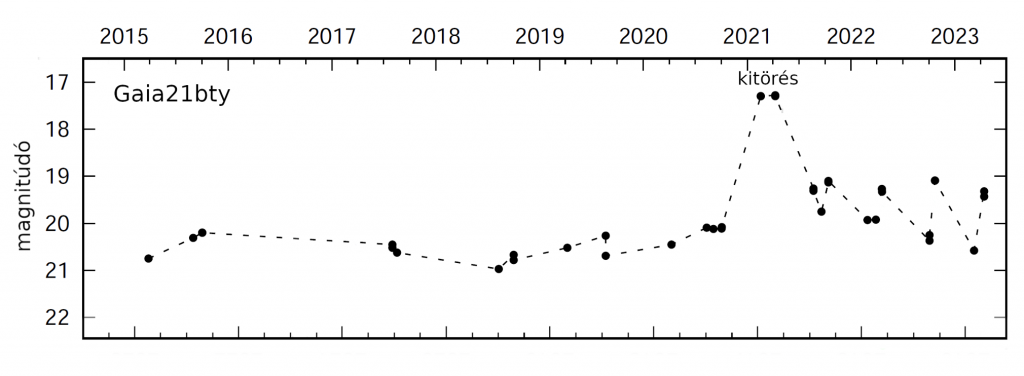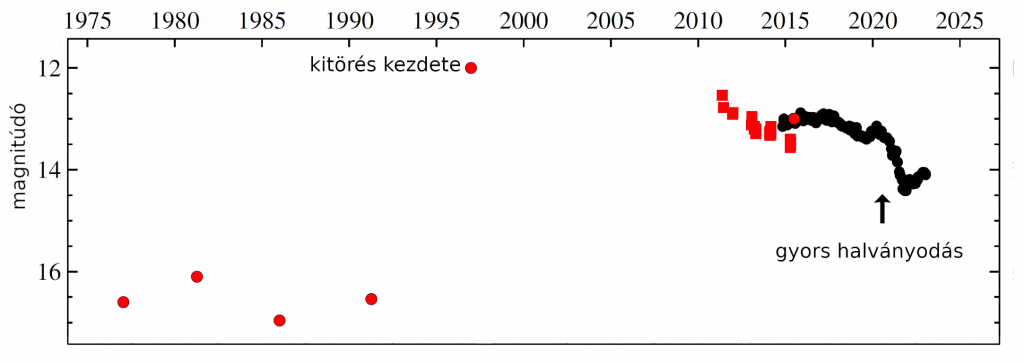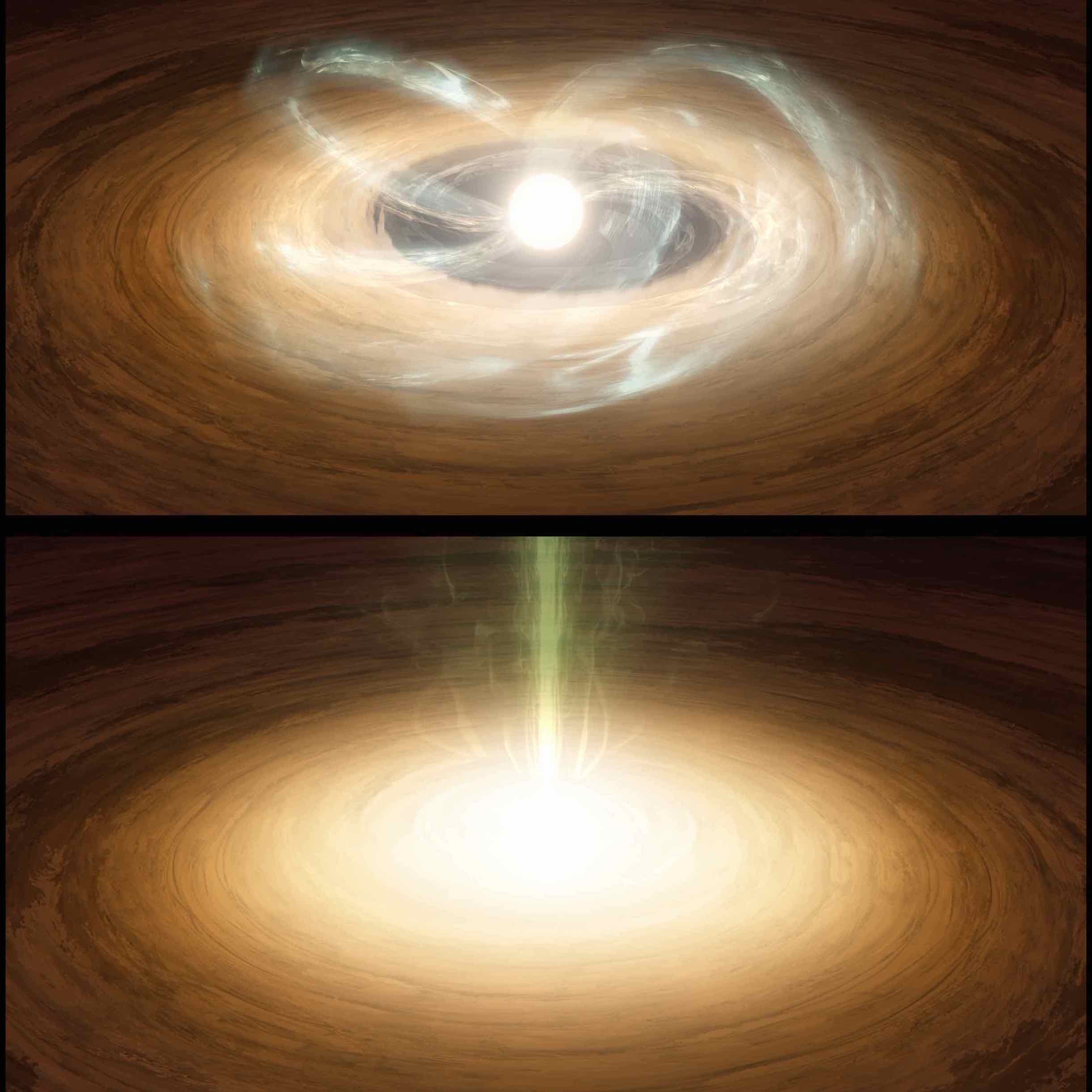There are still many unanswered questions about the formation of sun-like stars. One of these is how they reach their final mass.
Stars are born in molecular clouds in interstellar space during gravitational collapse. Additional material from the cloud falls on the initials of the formed stars, which increases the mass and momentum of the initial star, and thus the speed of the initially slow rotation is accelerated, and a flat circular disk is formed around the initials of the star. Falling matter reaches the surface of the young star from the accretion disk. The gravitational energy released heats the newborn star, then deuterium fusion begins and the magnetic field of the starting star is formed. Most of the infalling material is directed by the magnetic field from the disk to the star, but particles with a higher velocity fly almost perpendicular to the plane of the disk. These high-speed winds blow the cloud away from the surrounding star in a few hundred thousand years. This stops further growth of the disk’s mass, and then the newborn star surrounded by a disk of dust and gas becomes visible in the visible light spectrum.
Most young stars produce changes in brightness on a time scale of days, weeks, or months. Changes in brightness can be traced back to several physical causes. Part of the smaller brightness changes with an amplitude of a few tenths of an order and a timescale from days to weeks is due to the fact that matter from the disk does not flow uniformly into the star. Some young stars also show a long-term change in brightness, on an annual to decade scale, with an amplitude of 2 to 5 magnitudes. These are volcanic young stars, in which the brightness is caused by instability that temporarily increases the amount of material falling from the accretion disk onto the star, as shown in the figure below.
There are two main types of volcanic young stars. Those of the EXor type produce radiances on a time scale from several months to years, with an amplitude of 2-4 magnitudes, which recur every few years. Those of the FUor type brighten up to magnitude 5 and erupt for decades. Of the FUors known so far, we don’t know which have completed their eruptions, and only cases of temporary blackouts are known. In addition to the FUor and EXor types, there are other young, eruptive stars of an intermediate state. However, the light curve alone is not sufficient to classify young stars. Optical and near-infrared spectrometers are required especially in the initial stage of polishing. One of the primary differences between FUor and EXor-type stars is that while the spectra of the former usually have absorption lines, the latter have emission lines. Both types are examples of tangential accretion (mass capture), a stage that all stars probably go through before reaching their final mass.
To date, we know of about 50 eruptive young stars. In order to understand episodic accretion and how stars reach their final mass, it is essential to detect as many volcanic young stars as possible. Sky survey programs, many of which are currently running, help with this. Chief among them is the survey of the skies with the Gaia space telescope, which covers the entire sky and is also capable of detecting faint objects.
It is operated by the European Space Agency (ESA). Jaya Since 2014, the Astronomy spacecraft has been providing the exact location and brightness data of more than a billion stars. the Jaya Its data is published approximately every two years, except for sources that undergo unexpected changes in brightness. A starlight curve that brightens or fades in a short period of time is a Jaya Science Alerts Publication of the system (scientific alert). Staff of the Space Astronomy and Planetary and Star Formation Team of Konkoli Tigi Miklos Institute of Astronomy of the Center for Astronomy and Earth Sciences Research (CSFK) Jaya They use the Science Alerts system to detect new volcanic young stars. if it was Jaya The Science Alerts system provides an alert of a possible young star, and data in public archives provides information about whether the object in the alert is indeed a young star. If this is the case, further optical, spectroscopic, and near-infrared measurements are necessary to discover the physical cause of the brightness changes.
In recent weeks, the group has also published two studies, a Jaya-The young, starting stars that were found were analyzed based on the alerts.
one of these, led by Michaye Siwak, is investigating the young star Gaia21bty, which shone by three magnitudes between October 2020 and February 2021. As an interesting fact, the source name refers to the discovery by Gaia, it shows the year of the alert, then the event serial number in ABC letters (aaa…zzz ). After measuring and analyzing its spectrum, it was soon possible to conclude that it is probably a young, eruptive star of the FUor type. Based on the data, it was also possible to determine how much material falls on the star from the disk per unit time, and the determined value was similar to that measured for already known FUors.

But after half a year, the star’s luminosity has decreased dramatically in the optical range and has almost approached its pre-explosion state, making it more similar to EXors than to FUors on the explosion time scale. Another interesting thing is that the decrease in brightness in the infrared range is not yet visible in data from the Wide Field Infrared Explorer (WISE) space telescope. The data so far has led to the conclusion that the star’s light decreased in the visible range as a result of condensation formed in the disk around the young star as a result of the eruption, but the outburst caused by the mass fusion increase is not over yet. Further study of the star is needed to confirm this conclusion.
last, By Zofia Nagy and colleagues, a recently accepted paper analyzing the case of Gaia21elv, which is quite different from Gaia21bty. In the case of the Gaia21 principle, the Gaia Alerts system indicated a dimming of a known young star. Based on the previous photometric data of the star, it was found that in addition to being a young star, after it shone between 1990 and 1995, its brightness was still close to the bright state, so based on its light curve, it is. Possibly a young, eruptive FUor star.

To establish the origin of FUor and to understand why the star is fading, we measured the optical and near-infrared spectra. Information obtained from the spectra (such as the presence of absorption lines and the amount of matter falling from the disk into the star per unit time) confirmed the origin of the FUor star. This is only the third FUor volcanic young star identified by Gaia Alerts. As it turns out, the star’s eruption is not yet nearing its end. The sudden drop in brightness could be due to a similar phenomenon as in the case of Gaia21bty: dimming caused by condensation in the disk around the star.
the Jaya Based on the results so far, the Science Alerts system has proven successful in identifying new, young volcanic stars. the Jaya The space telescope will continue to provide data on the brightness and distance of the stars of our Milky Way for years to come, and many interesting results can be expected based on them, including young stars.
Siwak et al.:Gaia21bty: EXor light curve showing FUor spectrumMNRAS, accepted for publication
Nagy and others:Gaia has alerted Gaia21elv of the FUor star to be fadingMNRAS, accepted for publication
comment












































